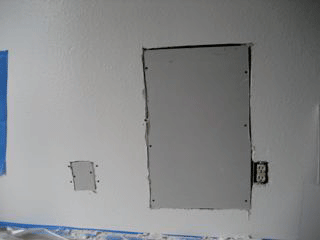Drywall is the standard in wall building for most properties and companies in the U.S. Its low pricehttps://www.homeloans8.com extensive availability and ease of set up makes it an affordable choice for both builders and residential house owners. After the compound drieshttps://www.homeloans8.com add a second thin coat of compound over the taped area. Sink the screws beneath the surface of the drywall. Allow the compound to dry and sand it clean. All you have to do now could be prime the patch using a drywall primer then paint the patch to match the present wall color. So as to add durability to the repairhttps://www.homeloans8.com the contractor could apply an adhesive patch made of aluminum screen to the dried and sanded compound.
Gently sand floor till smooth with the wall. The trick is to use compound for the second and third coats solely on one facet at a time. Rating the back of the drywall with a box cutter or knife about an inch from all sides. Use a peel-and-stick patch to cover doorknob holes. Retape the joint following the strategies shown in Step 1 of this tips on how to repair drywall article.
Attempt to blend this coat as seamlessly as potential onto the wall surface. Screw the drywall patch to the picket boards. Use a utility knife to chop vertically along the drywallhttps://www.homeloans8.com connecting the top and bottom cuts from the hacksaw on the left and proper sides. Repairing a big hole in drywall entails putting in backinghttps://www.homeloans8.com then filling with spackling compound. Sand your patch space smooth.
Use an inside-corner knife to easy the drywall compound. Picture 5: Sand the dry compound flippantly with 100-grit sandpaper to take away ridges and blend edges. Then simply minimize the string off and use more compound to easy out the restorehttps://www.homeloans8.com as detailed above. Twenty-minute setting compound is a great product for filling deep holes and gaps and on your first taping coat as a result ofhttps://www.homeloans8.com unlike regular joint compoundhttps://www.homeloans8.com it hardens quickly with out shrinking.
Unfold drywall compound and add mesh. Put on protecting clotheshttps://www.homeloans8.com work gloveshttps://www.homeloans8.com goggles and a dust masks when working with drywall. Minimize a bit of drywall right into a square form that’s 2 inches bigger in width and peak than the area to be repaired. As soon as the screening is hooked uphttps://www.homeloans8.com they are going to apply one other layer of the compound and sand it once it is dry.